|
|
|
|
|
|
| David Wilson speaks at the Sadharan Brahmo Samaj Library |
Sculptural portraits of Raja Rammohun Roy
 Most
of us are probably familiar with the well-known
portrait of Raja Rammohun Roy that was painted by
the English Portrait painter Henry Peronnet Briggs
around 1831-2, a commission from Miss Castle, with
whom Rammohun was to spend his final days at Stapleton
Grove in Bristol, England, in September 1833. That
portrait (now in the Bristol City Museum, to whom
it was given by Miss Castle's aunt in 1841) was
exhibited at the Royal Academy's annual exhibition
in London in 1832, where it was praised by a number
of art critics. Most
of us are probably familiar with the well-known
portrait of Raja Rammohun Roy that was painted by
the English Portrait painter Henry Peronnet Briggs
around 1831-2, a commission from Miss Castle, with
whom Rammohun was to spend his final days at Stapleton
Grove in Bristol, England, in September 1833. That
portrait (now in the Bristol City Museum, to whom
it was given by Miss Castle's aunt in 1841) was
exhibited at the Royal Academy's annual exhibition
in London in 1832, where it was praised by a number
of art critics.
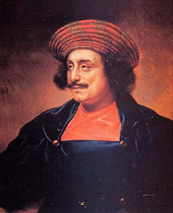 Many
of us are probably also familiar with the American
painter Rembrandt Peale's Portrait of Rammohun Roy,
apparently painted at London in August, 1833, about
six weeks before Rammohun's death and shortly before
he made his final journey, to Bristol. Carla Contractor
has kindly informed me that the portrait, of which
there are at least two versions (one owned for a
long time by the New York Historical Society, and
one in the collection of the Peabody Essex Museum,
Salem, Massachusetts) was executed at the request
of Jared Sparks, who was Peale's religious minister
in Baltimore, United States, and that Rammohun Roy
had planned to visit the United States towards the
end of 1833 and hoped then to meet Sparks. Sadly,
that visit never took place. Many
of us are probably also familiar with the American
painter Rembrandt Peale's Portrait of Rammohun Roy,
apparently painted at London in August, 1833, about
six weeks before Rammohun's death and shortly before
he made his final journey, to Bristol. Carla Contractor
has kindly informed me that the portrait, of which
there are at least two versions (one owned for a
long time by the New York Historical Society, and
one in the collection of the Peabody Essex Museum,
Salem, Massachusetts) was executed at the request
of Jared Sparks, who was Peale's religious minister
in Baltimore, United States, and that Rammohun Roy
had planned to visit the United States towards the
end of 1833 and hoped then to meet Sparks. Sadly,
that visit never took place.
The portrait by Peale seems to reveal a significant change in Rammohun's appearance between 1831/2 and the summer of 1833, and probably signifies declining health.
There are many other two dimensional portraits of Rammohun Roy, most of them derivative, and based on earlier portraits. Here I am going to consider sculptural portraits of Rammohun Roy.
The Raja Rammonhun Roy Memorial Museum in Kolkata has amongst its prized exhibits a replica death mask of Rammohun Roy. The original death mask is in the storage facility of a Scottish museum. A late 20th-century bust of Rammohun Roy by Niranjan Pradhan, a gift in 1994 from Joyti Basu, then Chief Minister of West Bengal, to the Lord Mayor of Bristol in 1995, is displayed in the Bristol City Council House. Pradhan's full-size bronze statue of Rammohun Roy was installed on College Green, Bristol, in 1997, a gift to the city from businessmen in Kolkata.
In India there are several portrait busts of Rammohun Roy in marble or other material, but these are largely derivative, that is to say that, for Rammohun's features they rely on other representations of him, mainly pictorial.
What seems to have been largely unknown until last year (when it was discovered) is that Rammohun Roy was sculpted in marble by one of the leading sculptors working in London in the early 1830s, and, what is more important, the occasion seems to be the first and only time that Rammohun actually gave sittings to a sculptor, so that we know his bust was modelled from the life and represents what the sculptor perceived from having Rammohun Roy sitting before him. A bust depicting Rammohun and made in such circumstances is likely to be the best three-dimensional representation we possess of his features , and the more so if the sculptor who made the bust was a first rate artist. Happily, that is the case.
The sculptor was George Clarke (1796-1842) from Birmingham in the Midlands of England, and who learned his craft as a very young man, sending very competent portrait busts to London for exhibition in the Royal Academy's annual exhibitions. In 1821, he moved to London and became an assistant in the studio of Sir Francis Chantrey, the most famous sculptor of the age, and a leading maker of figures and portrait busts. Chantrey's skills as a modeller are legendary and his work is very highly regarded even today internationally as well as in Britain. He made a number of statues for India as well as other parts of the then British empire.
Clarke obviously learned something useful in Chantrey's studio and Chantrey's own brilliance must have rubbed off on Clarke, because such of his own portrait busts as survive or can be located clearly reflect Chantrey's style and Clarke eventually earned the nickname 'the Birmingham Chantrey' . But Clarke was a brilliant modeller in his own right and there are several literary accounts of his work where the reviewer has highly praised Clarke skill and his ability to produce an excellent likeness, and commented that he was destined for the highest place in his profession. Sadly, Clarke died at the age of 46, suddenly and unexpectedly, only four months after the death of Chantrey himself, and so he never lived long enough to fulfil the promise that was expected of him. From all the accounts we have of his work, he would undoubtedly have risen to the most eminent position as a sculptor had he lived longer and would now be a very famous artistic name. Unfortunately there is no known portrait of Clarke.
Prior to his death in Bristol, England, on 27 September 1833 - most likely in the early months of 1832 - Rammohun Roy sat for his marble portrait bust to the sculptor, George Clarke, and he would doubtless have given the sculptor several (possibly up to six or seven) sittings (each lasting probably between an hour and two) to enable the bust to be modelled, almost certainly in clay. After the initial clay model had been made from the sittings, a mould would be taken off the model which would enable a plaster bust that exactly replicated the clay model to be cast in the mould. This would have been done because the clay model would eventually dry out and crack and it was essential to preserve the model or an exact replica of it if the clay itself was not to be fired in a kiln and turned into a terracotta bust (firing clay in kilns was an inherently dangerous process that sometimes resulted in the loss of the clay bust). The plaster cast would then serve as the model by reference to which the sculptor carved the marble version of the bust, a process that would have taken many months, and would doubtless have been carried out along with a number of other sculptural projects on which Clarke was working at that time.
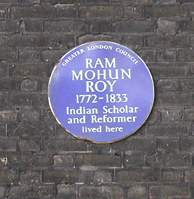 Rammohun
Roy had a personal dislike of portraits and personal
adulation, but agreed to sit to the sculptor, Clarke,
as a favour to Basil Montagu, whose own bust had
earlier been carved by Clarke. Montagu was a friend
of Rammohun Roy, and he held literary soirees at
his house in Bedford Square, very near to the house
of the Hare Bothers at which Rammohun Roy lived
while in London. Rammohun's residency in Bedford
Square is marked by a famous 'Blue Plaque'. Rammohun
Roy had a personal dislike of portraits and personal
adulation, but agreed to sit to the sculptor, Clarke,
as a favour to Basil Montagu, whose own bust had
earlier been carved by Clarke. Montagu was a friend
of Rammohun Roy, and he held literary soirees at
his house in Bedford Square, very near to the house
of the Hare Bothers at which Rammohun Roy lived
while in London. Rammohun's residency in Bedford
Square is marked by a famous 'Blue Plaque'.
The marble bust itself was completed by October 1833, because in that month, only one month after Rammohun Roy's death, the literary and art critic of The Athenaeum reported:
'We have been admitted to a private view of the bust of the late Rammohan Roy, executed by Mr Clarke, the only artist, we believe, who was allowed to trace in marble the likeness of that distinguished individual. Mr Clarke has done justice to his subject; the likeness is good and the general execution creditable.'
Interestingly, the report of the bust seems to have generated much interest among the press. Clarke's marble bust of Rammohun Roy was exhibited at the Royal Academy, London, in 1834.
Unfortunately all trace of Clarke's marble bust has disappeared and strenuous efforts to locate it have been to no avail. It is possible that it is India, or that it is in some private collection somewhere in England, the sitter and sculptor unknown to the present owner. Clarke often did not sign his busts and did not inscribe them with the name of the person depicted, which makes identification particularly difficult. It is, of course, quite possible that the bust was destroyed in an enemy bombing raid in England during the Second World War, when so many great works of art were destroyed. One can only begin to imagine the marble bust's importance and its worth if it turned up today. Interest in the portraiture of leading figures from the history of India is considerable, as testified by the sale for £1.7million (168 million Rupees) in 2007 of a marble portrait bust of Maharajah Duleep Singh carved in Rome in 1860 by John Gibson.
Although the marble bust is missing (and most likely destroyed), in the library of the Sadharan Brahmo Samaj in Kolkata there is a life-size plaster cast replica of the bust, which almost certainly was made by the sculptor Clarke.
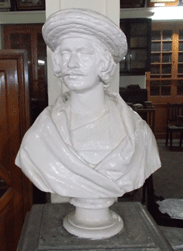 The plaster cast would have been made in a new mould
taken off the plaster bust that was made from the
mould of the original modelled clay bust, so it
is practically identical with the original model.
The plaster bust in the library of the Sadharan
Brahmo Samaj has suffered some damage at some point
in its existence. It has been repaired and painted
white to resemble marble. It was apparently the
gift in 1936 of Ritendranath Tagore, great grandson
of Dwarakanath Tagore and nephew of the Nobel laureate
Rabindranath Tagore. As we know Dwarkanth Tagore,
Rammohun Roy's great friend, commissioned and paid
for Rammohun's tomb monument at Arnos Vale cemetery
in Bristol, England.
The plaster cast would have been made in a new mould
taken off the plaster bust that was made from the
mould of the original modelled clay bust, so it
is practically identical with the original model.
The plaster bust in the library of the Sadharan
Brahmo Samaj has suffered some damage at some point
in its existence. It has been repaired and painted
white to resemble marble. It was apparently the
gift in 1936 of Ritendranath Tagore, great grandson
of Dwarakanath Tagore and nephew of the Nobel laureate
Rabindranath Tagore. As we know Dwarkanth Tagore,
Rammohun Roy's great friend, commissioned and paid
for Rammohun's tomb monument at Arnos Vale cemetery
in Bristol, England.
The sculptor George Clarke's original model and the marble bust he craved by reference to it are missing. We have the plaster bust in the library of the Sadharan Brahmo Samaj in Kolkata, which is a replica of the model for the marble bust, almost certainly made by the sculptor, George Clarke. Until very recently, that was the only visual record we had of the appearance of the marble bust, and until the plaster bust was identified in 2013, its sculptor was unknown. It was also unknown until then that the bust was modelled from the life. In fact, it is an excellent depiction of Rammohun Roy in three dimensions, having been made by one of the finest sculptors of the age.
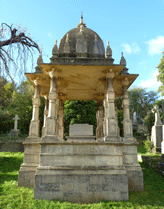 But
last year another replica of the bust was also discovered,
this time in Ivory, a replica that is practically
as important as the original bust by George Clarke.
Before discussing that newly discovered ivory bust,
it is necessary to record some facts about an important
figure in the history of British engineering and
art. But
last year another replica of the bust was also discovered,
this time in Ivory, a replica that is practically
as important as the original bust by George Clarke.
Before discussing that newly discovered ivory bust,
it is necessary to record some facts about an important
figure in the history of British engineering and
art.
An exceptionally talented man, Benjamin Cheverton (1796-1876) operated effectively as both a scientist and an artist in the early Victorian period. Cheverton's principal activity was as a maker of reduced-size sculpture, mostly in ivory. He was not a creative sculptor, nor even a sub-contractor working for other independent sculptors. Nevertheless, his portrait busts and other sculptures - made by a machine which he, as an inventor, perfected - are of very high quality. It is for these exquisite small busts that he is chiefly remembered and celebrated.
Cheverton was an artist who perfected a reducing machine with the assistance of the engineer John Isaac Hawkins that made it possible to create small scale replicas of sculptures. The machine - a 'three-dimensional pantograph' - was first made around 1828 and finally patented on 16 January 1844 (an example is in the Science Museum, London).
With the aid of his reducing machine Cheverton was able to produce ivory miniatures of the busts of the 'great and good' made by the leading British sculptors of the day and from the preceding century. They are identical in detail with the original busts, but produced normally on a diminutive scale, usually only a few inches high. Cheverton's work demonstrates considerable refinement and delicacy of execution. His ivory busts are very sought-after and highly collectable. One, of a fairly undistinguished lady, was offered for sale in 2013 by an Australian art dealer for £45,000 (about $.5 Million Rupees). Cheverton' s busts are in many private collections and in major world museums, such as the Victoria and Albert Museum, London, the Science Museum, London, and the Art Gallery of Ontario, Canada, which latter institution has an exceptionally fine and large collection of Cheverton busts donated to the museum by the late The Rt. Hon. Lord Thomson of Fleet (1923-2006).
The ivory busts were mounted on dark marble or stone bases. Sometimes, Cheverton made a base out of different coloured marble. There are bases made of yellow marbles and even one made in red marble, in the latter case because the colour red for a base was a particularly fitting way in which to demonstrate reverence for the person depicted by the bust.
Cheverton is thought to have produced several hundred ivory busts in this way, including a bust of Queen Victoria, a replica of the famous marble bust of the Queen sculpted by Sir Francis Chantrey. That replica ivory bust by Cheverton is now in the collection of the Victoria and Albert Museum in London. Unusually, Cheverton's ivory bust of Queen Victoria is approximately twice the size of most of his other ivory busts.
Cheverton's unpublished accounts record the making of probably two ivory busts of Rammohun Roy. These were exact replicas in miniature of George Clarke's bust. Clarke supplied his model of the bust of Rammohun Roy to Cheverton who then would have applied his reducing machine to the model and by careful operation of the machine would have been able to carve in ivory an exact replica in miniature of the bust by Clarke. The ivory busts were made by Cheverton for Clarke himself.
Clearly Cheverton's miniature ivory version of Clarke's bust of Rammohun Roy would be identical with Clarke's bust, save for its small scale, as it was copied directly from the model by Clarke, and it would therefore be the most perfect three dimensional representation of the Raja absent the missing bust by Clarke. Indeed, until the very recent realisation that the bust in your library in Kolkata was a plaster cast of Clarke's bust, it must long have been wondered by many what Rammohun Roy actually looked like in three dimensions. Well, very happily, we now know exactly how he looked in 1832, the year before that in which he died, because one of Cheverton's Ivory busts of Rammohun Roy - which he made for the sculptor Clarke and exactly copied from Clarke's own bust - has been found. And the library of the Sadharan Brahmo Samaj in Kolkata possesses the plaster cast of Clarke's bust, which is practically identical with the ivory bust, just larger in scale, although it has suffered some damage.
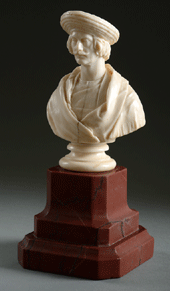 The
ivory bust of Rammohun Roy carved by Cheverton is
approximately 4 inches in height. It is mounted
on a red antico-rosso marble base, the colour red
signifying veneration of Rammohun Roy. The
ivory bust of Rammohun Roy carved by Cheverton is
approximately 4 inches in height. It is mounted
on a red antico-rosso marble base, the colour red
signifying veneration of Rammohun Roy.
The miniature ivory bust was once owned by the sculptor George Clarke. It is now in a private collection in England.
This ivory bust of Rammohun Roy is probably the most unusual, exotic and exceptional of all the busts in ivory made by Cheverton, just as it was almost certainly the most unusual, exotic and exceptional of all the busts made by the sculptor Clarke. The ivory bust and he plaster bust in the library of the Sdharan Brahmo Samaj are of very great and exceptional importance in the iconography of Rammohun Roy. They are as important as, and arguably more important than, the bust of Maharajah Duleep Singh, to which I referred earlier.
This ivory portrait of Rammohun Roy by Cheverton is believed to be unique. While there is evidence that at least one other ivory bust of Rammohun Roy by Cheverton existed, there has been no record of its appearance in more than 180 years, and it must be presumed lost. The ivory bust and the plaster bust provide a wonderful (indeed the only) accurate study of the great man in three dimensions.
The presentation was derived from Dr Wilson's book, A Portrait of Raja Rammohun Roy: A Masterpiece in Ivory, London, 2013. Copies of the book may be obtained from David Wilson who can be contacted at: info@davdwilsonfineart.com |
|
|
|
|
|